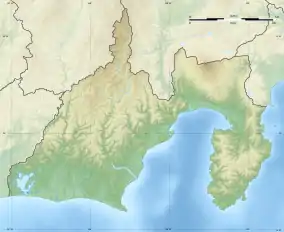Sengo ruins
Sengo ruins (千居遺跡, Sengo iseki) is an archaeological site containing the ruins of an early through mid-Jōmon period settlement located in what is now part of the city of Fujinomiya, Shizuoka in the Tōkai region of Japan. The site was designated a National Historic Site of Japan in 1975.[1]
千居遺跡 | |
 Sengo ruins | |
 Sengo ruins  Sengo ruins (Japan) | |
| Location | Fujinomiya, Shizuoka, Japan |
|---|---|
| Region | Tōkai region |
| Coordinates | 35°17′28.5″N 138°35′11.0″E |
| Type | settlement |
| History | |
| Periods | Jōmon period |
| Site notes | |
| Ownership | National Historic Site |
| Public access | None |
Overview
The site is located at the southeastern foot of Mount Fuji at an altitude of 398 meters along a ridge extending north-to-south. It was discovered before World War II, but was only excavated from the 1970s. The site was found to contain the foundations of twenty pit dwellings arranged in a ring surrounding a 50-meter diameter central plaza. Each pit dwelling was from three to 7.3 meters in diameter, with some of the foundations overlapping. Numerous Jōmon period pottery shards were also recovered from the site. The entire site was covered in a layer of ash from the eruptions of Mount Fuji.
Early reports of a large stone circle made from piled river stones were later refuted when the monument was found to be an Edo period structure associated with the Fuji cult.
References
- "千居遺跡" (in Japanese). Agency for Cultural Affairs.
External links
![]() Media related to Sengo ruins at Wikimedia Commons
Media related to Sengo ruins at Wikimedia Commons
- List of Cultural Properties in Fujinomiya City (in Japanese)
